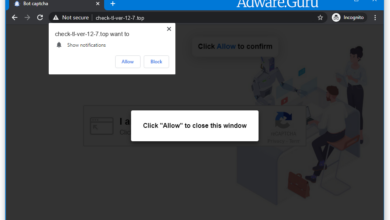Remove Micro Virus (.micro Files Ransomware) – CryptoWall Ransomware
Micro Virus – Details
The Micro stands for a ransomware-type infection. The virus comes from the CryptoWall ransomware family. Micro was elaborated specifically to encrypt all major file types. Once the file is encrypted people are unable to use them. Micro adds the “.micro” extension for each file encrypted by it. For example, the file “myphoto.jpg“, when encrypted by Micro, will be renamed into “myphoto.jpg.micro“. As quickly as the encryption is completed, Micro places a special text file into every folder containing the encrypted data.The message given by Micro text file requesting the ransom is definitely the like the statements given by other ransomware virus representatives coming from the CryptoWall clan. It literally discusses that the info is encrypted which the only way to restore it is to use a a distinct decryption key. Regretfully, this is definitely true. The kind of cryptography mechanism applied by Micro is still not appropriately examined. Still, it is absolutely certain that each victim may be given the specific decryption key, which is absolutely unique. It is impossible to bring back the files without the key available.
Another technique of Micro is that the victims cannot gain access to the key. The key is kept on a specific server run by the frauds connected with Micro ransomware. To get the key and recover the important info people need to pay the ransom.
Micro encrypted your documents, but that might not be the only damage done to you. The ransomware might still be hidingon your computer. To identify whether this holds true, we suggest downloading GridinSoft Anti-Malware.
Download GridinSoft Anti-Malware
GridinSoft Anti-Malware Review, How to get free trial?, EULA, and Privacy Policy.
However, regardless of the requested quantity, people should keep away from paying the ransom. Cyber frauds are not fair, so they tend to completely ignore what their victims feel about the problem, even when the payment reaches their pockets. This is why paying the ransom generally does not provide any positive outcome and people simply waste their money for nothing.
We strongly recommend that you do not contact these crooks and definitely do not transfer money into their accounts. It is said to admit that there are no utilities able to crack Micro ransomware and to recover the information data for free. Therefore, the only right decision is to recover the lost data from the available backup.
Virus Summary
| Name | Micro Ransomware |
| File Extension | .micro |
| Type | Ransomware |
| Family | CryptoWall |
| Short Description | The ransomware encrypts all the data stored on your system and requires a ransom to be paid on your part supposedly to recover your important files. |
| Symptoms | File encryption by the ransomware is performed by means of the AES and RSA encryption algorithms. Once the encryption is completed, the ransomware adds its special micro extension to all the files modified by it. |
| Distribution Method | Spam Emails, Email Attachments |
| Removal Tool | GridinSoft Anti-Malware |
Keep in mind that the world wide web is now overwhelmed with threats that look comparable to Micro ransomware. Malicious programs of such kind are normally elaborated to encrypt crucial information and to set forth the demand prior to the user to pay the ransom. The peculiarity of all such ransomware threats is that all apply a similar algorithm to generate the unique decryption key for files decryption.
Hence, as long as the ransomware is still being developed or has some hidden bugs, by hand recovering the information is just not feasible. The only method to avoid the loss of your crucial data is to frequently create backups of your important information.
Remember that even if you create such backups, they need to be put into a special storage utility not connect to your main computer. You may use the USB Memory Stick or external hard disk for this purpose, or refer to the help of the cloud storage. If you store your backup files on your common system they may be encrypted along with other files, so it’s definitely not a good storage place.
How did ransomware infect my system?
There are numerous methods used by online frauds to distribute Micro ransom virus. Even though it doubts how exactly Micro injects your computer, there are some leaks through which it may infiltrate the system:
- integration with third-party software application, especially freeware;
- spam e-mails from unknown senders;
- websites rendering free hosting services;
- pirated peer-to-peer (P2P) downloads.
Typically Micro virus may exist as some genuine software, for example, in the pop-ups advising users to carry out some crucial software updates. This is the common trick used by online scams to persuade people into downloading and installing Micro infection manually, by ways of their direct participation in the installation process.
Additionally, the criminals might describe different email spam techniques to inject malicious codes into copmuter. So, they may describe to sending unsolicited spam emails with tricky notices promoting users to download the attachments or click on certain download links, for example, the ones encouraging users to open some photos, files, tax reports or invoices.
Needless to mention, opening such documents or clicking on such dangerous links may seriously harm the system. Fictitious Adobe Flash Player update alerts may result in Micro virus injection. When it comes to the cracked software, these illegally downloaded programs may also include harmful codes leading to Micro secret installation. Lastly, injection of Micro may occur by methods of Trojans that privately get injected into the system and set up harmful utilities without the user’s authorization.
Is there any way to avoid the injection of Micro ransomware?
Despite the fact that there is no 100% guarantee to avoid your PC from getting infected, there are some pieces of advice we wish to show with you. Firstly, be really careful when you browse the web and particularly while downloading complimentary apps. Stay away from opening suspicious email attachments, especially when the sender of the email is not familiar to you.
Keep in mind that some freeware installers may consist of other unwanted utilities in the package, so they may be destructive. Make certain that your current anti-virus and your entire operating system is always duly updated.
Of course, downloading pirated software is prohibited and may result in necessary damage to be produced your system. For this reason, stay away from downloading cracked software. You are likewise strongly advised to reconsider your existing security software and potentially switch to another security solution that can render better services of protecting your PC.
Below please find the quotation from the Micro text file:
NOT YOUR LANGUAGE? USE hxxps://translate.google.com What happened to your files ? All of your files were protected by a strong encryption with RSA-4096. More information about the encryption keys using RSA-4096 can be found here: hxxp://en.wikipedia.org/wiki/RSA_(cryptosystem) How did this happen ? !!! Specially for your PC was generated personal RSA-4096 KEY, both public and private. !!! ALL YOUR FILES were encrypted with the public key, which has been transferred to your computer via the Internet. Decrypting of your files is only possible with the help of the private key and decrypt program, which is on our secret server. What do I do ? So, there are two ways you can choose: wait for a miracle and get your price doubled, or start obtaining BITCOIN NOW! , and restore your data easy way. If You have really valuable data, you better not waste your time, because there is no other way to get your files, except make a payment. For more specific instructions, please visit your personal home page, there are a few different addresses pointing to your page below: 1. hxxp://pot98bza3sgfjr35t.fausttime.com/14645B55E66E2C9 2. hxxp://h5534bvnrnkj345.maniupulp.com/14645B55E66E2C9 3. hxxp://i4sdmjn4fsdsdqfhu12l.orbyscabz.com/14645B55E66E2C9 If for some reasons the addresses are not available, follow these steps: 1. Download and install tor-browser: hxxp://www.torproject.org/projects/torbrowser.html.en 2. After a successful installation, run the browser and wait for initialization. 3. Type in the address bar: wbozgklno6x2vfrk.onion/14645B55E66E2C9 4. Follow the instructions on the site. !!! IMPORTANT INFORMATION: !!! Your personal pages: hxxp://pot98bza3sgfjr35t.fausttime.com/14645B55E66E2C9 hxxp://h5534bvnrnkj345.maniupulp.com/14645B55E66E2C9 hxxp://i4sdmjn4fsdsdqfhu12l.orbyscabz.com/14645B55E66E2C9 !!! Your personal page Tor-Browser: wbozgklno6x2vfrk.onion/14645B55E66E2C9 !!! Your personal identification ID: 14645B55E66E2C9
Screenshot of files with “.micro” extension added by the ransomware:

Use GridinSoft Anti-Malware to remove Micro ransomware from your computer
1.Download GridinSoft Anti-Malware.
You can download GridinSoft Anti-Malware by clicking the button below:
2. Double-click on the setup file.
When setup file has finished downloading, double-click on the setup-antimalware-ag.exe file to install GridinSoft Anti-Malware on your computer.

An User Account Control asking you about to allow GridinSoft Anti-Malware to make changes to your device. So, you should click “Yes” to continue with the installation.

3. Press Install button for run GridinSoft Anti-Malware.
3.Once installed, GridinSoft Anti-Malware will automatically run.
4. Wait for the GridinSoft Anti-Malware scan to complete.
GridinSoft Anti-Malware will automatically start scanning your computer for Win Speedup 2018 and other malicious programs. This process can take a 20-30 minutes, so we suggest you periodically check on the status of the scan process.

5. Click on “Clean Now”.
When the scan has completed, you will see the list of infections that GridinSoft Anti-Malware has detected. To remove them click on the “Clean Now” button in right corner.








